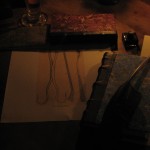Dim lights and sawbones
Posted By Doctor Clift on January 17, 2012
We’ve had some very dark and stormy nights here on the mountain of late, and it takes me back to a night back in October, when we had an uncharacteristically early snowstorm, and power outage. While for many people I know, this would be cause for crisis and chaos- I found it to be a great opportunity to be forced into doing something I hadn’t done for awhile- study 18th Century medical literature!
Just prior to this at Ligonier, I had been given several new books, and I continue to intensely read Samuel Sharp’s Treatise on Surgery with great excitement, so I sat them all at my dining table, along with 2 lanterns, some more candles for extra light, a notebook and pen, and a glass of good scotch. Looking at it in the dim light, I couldn’t help but think about those studying, or even working by candlelight as apprentices or students of Medicine, and how difficult that must have been. I know that for my eyes to see the small writing and not have the book right up against my nose, and at times I had to find unique angles in order to keep the shadows from darkening important words.
This night, I had finally gotten the opportunity to really study in depth the process of Amputation in Sharpe’s Treatise on Surgery. I had skimmed it several times, but being able to take in the full process, and the personal notations that Sharpe puts into his treatise. Sharpe’s illustrations of his tools in his treatise are also very good (you can see the tools for removing the stone in the candlelit picture on the right.
Amputation in the 18th Century , was called the Capital Operation, and its easy to see why. It had the largest tools, had the largest mortality rate, and in many ways was the most technical surgery that a surgeon would perform. In some cases, this surgery was why surgeons were commonly called Sawbones, because that’s effectively what they were doing. But when you break down the procedure, its significantly more involved than the typical person would ever anticipate. Within a few short minutes, a surgeon is required to cut off circulation to the limb, divide the skin and muscles down to the bone in 2 slices, have their assistant pull the skin and muscles back to expose the bone, cut the bone in half, and then either cauterize the arteries and veins, or reach into the muscles to pull out and tie off all of the bleeders. And of course, your patient, even though they’re being held down by 4 of their closest, and strongest friends, is screaming and more than likely attempting to thrash about. I would have to think that out of all the surgeries studied, this would be the most traumatic and painful, which is probably why many patients died from shock during the procedure. (As a note: The fastest Pre Anesthetic amputation is attributed to Robert Liston, who could remove a limb in approximately 30 seconds, but the average was a minute to 3 minutes.)
Sharpe has many bits of information about the procedure of amputation, but a lot ofhis own unique ancedotes regarding the subject are divided by the different types of amputation he’s discussing. While the procedure is basically the same regardless of which limb, each area for amputation has its own caveats. For example, “There are in the Armies a great many Instances of Gun-shot Wounds of the Arm near the Scapula, which require Amputation at the Shoulder; but the Apprehension of losing their Patients on the Spot by the Hæmorrhage, has deterred Surgeons from undertaking it.” At the end of this statement he does believe that it is possible to do this procedure based on a tale of a miller who had his arm ripped off by the grist mill, but he doesn’t have the answers as to how to do it effectively yet.
Sharpe also speaks on when amputations should be performed in the cases of Gunshot Wounds, compound fractures, and all sudden accidents requiring amputation. He states that they are attended “with the best success” if immediately performed. He also alludes to the fact that amputation is somewhat an art, in that you have to have experiences to understand where best to cut for the best success of an amputation in cases of mortification (limb death.) Other tips that he gives the aspiring surgeon for amputation are to use silk thread to sew, and to apply a bit of Barley water or warm milk to the dressings to aid in healing. Whether or not either of these actually aids with that is unknown.
Reading these entries in the dim candlelight and trying to envision the procedures in my head as Sharpe described them, I can only imagine the difficulty, and the truly great skill that the surgeons would have had to have to perform the Capital Operation. I could not even imagine being a freshly released surgeons mate or young surgeon having to perform this operation the first time, or even assisting the first time. Then again, I’ve read current accounts of surgeons going to amputation, and dreading it as well. Perhaps even with the advancements we have today, this procedure is daunting and as scary in the bright lights of an operating room, than the dim lights of a house, castle basement, or flying hospital.


Comments
Leave a Reply